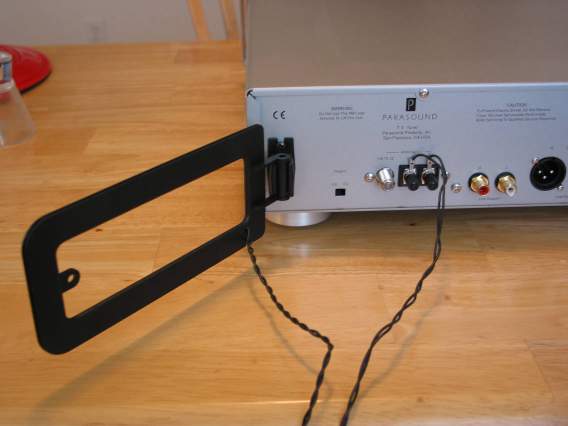|
|
 |
|
Specifications:
(Click photo above to see larger version.)
FM sensitivity: Mono - IHF 11 dBf
Stereo- IHF 37.2 dBf for 50 dB of quieting
AM sensitivity: IHF 10 µV/m
Signal to noise ratio: FM > 74 dB stereo, AM > 45 dB
FM stereo separation: 50 dB @ 1 kHz; 40 dB @ 10 kHz
Selectivity: FM 80 dB; AM 30 dB
FM frequency response: 30 Hz - 15 kHz +/- 1 dB
AM frequency response: 20 Hz - 5.5 kHz +/- 2 dB
Total harmonic distortion:
FM Mono < 0.08%;
FM Stereo < 0.2%
AM < 1%
Capture ratio: < 1.5 dB
AM Suppression: 60 dB
MSRP: $600
http://www.parasound.com
|
|
Introduction
FM radio was invented and developed by Edwin Armstrong during the early 20th
century, making high-fidelity radio broadcasting possible. General Electric
built the first production radio in 1937, which went for the hefty sum of
$400 ($5,000 in today’s dollars). The photo below shows what it looked like.

The first high power broadcast station (50,000 watt) started operating in
June, 1939, and the press described the FM broadcast system as “staticless”
and “providing the full tonal range”.
We have come a long way since then, and now most home theater receivers
have tuners that fit on a single chip.
However, there are still a few outboard FM/AM tuners that have their own
power supply, along with lots more circuitry and features to make them
perform better than small tuners in receivers.
HALO is the new line from Parasound, which currently includes the P3
preamplifier, the 2x125 watt THX Ultra 2 certified A23 power amplifier, and
the item being reviewed here, the T3 Tuner.
The Basics
The T3 Tuner features 60 presets, RDS (Radio Data System) support, remote
control, balanced (XLR) and unbalanced (RCA) outputs, external IR repeater
connection, a 9 pin RS-232 serial port for compatibility with home
automation control products, and excellent build quality.
The unit is rack mountable (2U height) with an optional adapter, and
supports 110 and 220v.

Setup
The T3 arrived in a large box and was well packed. Parasound includes both
AM and FM antennas and batteries for the remote. The documentation is in
English only and is well written. As soon as the unit arrived, I cleared a
space on my rack and connected it to my system: a Fosgate Audionics
Model 4 Preamplifier, an Audio Alchemy OM150 amplifier, and NHT 3.3 speakers
all connected with Kimber cables.
Antennas
The antennas that come with the unit worked very well in my area (Huntington
Beach, California). The FM antenna needs to be tacked to the wall fully
stretched out and as far up the wall as your spouse will allow. While I know
that the WAF (wife acceptance factor) of an antenna on the wall is low, try
getting her to listen to the results, and then try to hide the antenna
behind a picture or something.
With any tuner, antenna placement is critical, so be sure to experiment with
different placements. It would have been nice to have two sets of antenna
inputs so you could switch between the dipole wire and an input from, say,
your cable box (cable often supplies FM stations).

Construction
The unit is very well constructed. Weighing in at 15 pounds, it is heavier
that my preamp and DVD player put together. The buttons and tuner knob have
a nice feel, and the digital display is easily readable.
“Do Not Open, Risk of Electric Shock, etc.”
About the time I turned nine, I began my “I must take everything apart and
see what is inside” phase. I can still recall my first interaction with
110AC quite vividly: I was ten, my mom was in the next room watching Days of
our Lives and I had started taken the vacuum cleaner apart, but had
forgotten to unplug it. I got the outer casing off and was working on
getting the motor out when my screwdriver touched the power wires . . . it
held on to me for a good five seconds before the fuse blew. Moments later,
my Mom, an ER Nurse, was all over me: “What are you doing!?” I gave the
standard reply: “I don’t know."

Twenty eight years later, I am still going strong, and I am much better at
the “putting it back together” step (a process that, when I was young, often
fell to my father while I was sent to my room).
The cover comes off the T3 easily by removing six screws. The insides are
about what you would expect: small circuit board with a clean looking
layout. The exception was the large transformer located at the opposite end
of the case to reduce interference with the circuitry. It is a very heavy
duty unit, so I am sure that this thing is not underpowered.
A quick inspection of the bottom of the circuit board revealed clean solder
joints and not even a hint of last second reworking. This is a well designed
and constructed unit. I do not think any expense was spared.
Operation
When the T3 is off but plugged in, a faint blue glow will shine behind the
power button. Turn it on and the blue glow will shine from behind all of the
front panel buttons (Power, Memory, Mono, FM-AM and Select).
The T3 remembers both the station and tuning method when you turn it off and
back on, so you will not have to put it into your preferred mode (seek,
manual, etc.) every time you turn it on.
You can use the front controls to access the basic functions, but I expect
that most will use the remote.
Remote Control
The remote is easy to use and gives access to all functions of the system.
You can directly enter the frequency of the channel you want to listen to,
and it can seek from one channel to the next and manually tune weaker
stations that the seek tune skipped over. It also allows you to skip through
your presets.

The remote also has Mute, Source Select, and Volume controls that work with
the HALO P3 preamplifier.
Radio Data System - RDS
RDS is a system where small amounts of text data can be sent that have
information about the channel being listened to. This can include the
station call letters, the song being played, and other such information. In
my area, only a few channels had RDS.
This has the potential to evolve into a nice way to browse for stations. If
all of the stations would broadcast some standard info like rock, country,
talk, foreign, etc., it would make for very listener friendly radio. Until
then, we will all just have to continue to scan around and make our own
presets.
Sound
So, how does the unit perform? Quite well. Without doubt, it provides the
staticless full range sound that was the vision of Edwin Armstrong. The
sound is very clear and detailed. In the many hours I have spent listening
to it, I can say that I am very pleased. Every time I heard a song on this
radio that I also happened to have in my CD collection, I would quickly put
in the CD and listen to the song again for comparison. In every case, I
found that this unit had no deficiency. No, it was not identical, but it was
close enough that I did not care. In fact, besides a bit of a roll off on
the very top end, the only difference I was able to find in the best
broadcast was that the FM transmission would tend to hide any harshness in
the original recording.
This unit is able to clearly pull in stations that I cannot hear well on
other radios. Its level of noise rejection seems high, and even when there
is some noise, it seems suppressed and not too distracting.
Conclusion
If you are looking for a top notch separate tuner for your system, this is
it. It is well built, reasonably priced for the performance that it gives,
and sounds great. I listen to the radio more now that I have this unit in my
system, and I think that is the best thing that can be said about any
component that one purchases for a hi-fi system.
- Tod DeBie -
Terms and Conditions of Use

|









